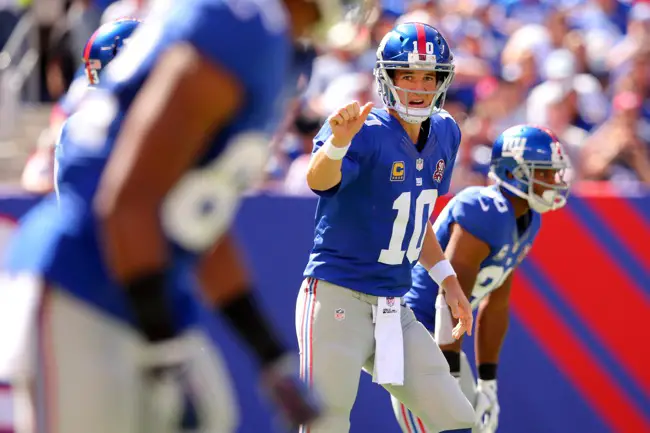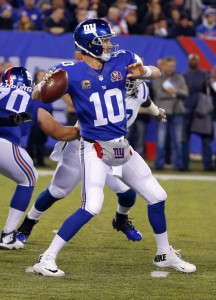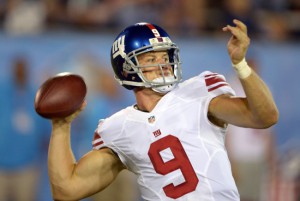[contentblock id=1 img=html.png]
Largely lost in the disappointing 6-10 season and the Odell Beckham hype was the fact that New York Giants quarterback Eli Manning experienced a renaissance in 2014. Approaching his mid-30’s and coming off arguably his worst season in the NFL in 2013, Manning rebounded with one of his best seasons in 2014. Indeed, had it not been for a dreadful 5-interception game against the San Francisco 49ers in November, Manning would have thrown only eight picks all season – his lowest ever in the NFL. His success was even more impressive when you consider he was coming off April ankle surgery, had a new offensive coordinator and position coach, was introduced to a radically-different offensive system, and lost his security blanket Victor Cruz early in campaign. Before the season, many said Manning was washed up and the team should move on. By season’s end, those thoughts had largely disappeared. Of all of the Giants’ personnel problems, the quarterback position is not one of them.
It originally looked like Ryan Nassib was going to have an up-hill fight for the #2 quarterback spot as the Giants had re-signed 2013 #2 quarterback Curtis Painter and had added quarterbacks Josh Freeman and Rusty Smith in free agency. But Freeman and Smith didn’t even make it to training camp, and Nassib clearly out-performed Painter in the preseason, completing 44-of-74 passes for 588 yards, five touchdowns, and no interceptions (107.3 quarterback rating). Nassib not only earned the promotion to the #2 spot, but the team was comfortable enough with him to cut Painter and only go with two quarterbacks on the 53-man roster.
Eli Manning rebounded from arguably his worst season in 2013 with one of his best seasons in 2014 under a new offensive coordinator, quarterbacks coach, and West Coast Offense-based system. The latter required him to reprogram his footwork and become accustomed to new route depths run by his receivers. Despite a year-long learning curve, Manning finished the season with 4,410 yards (second-highest total in his career and in franchise history), 30 touchdowns (one shy of his career-high in 2011), and 14 interceptions (13 fewer than he threw in 2013). Manning’s completion percentage (63.1) was a career-high. His passer rating of 92.1 was the second-highest of highest of his career (93.1 in 2009). And all of this despite the fact that Manning played behind a sub par offensive line that allowed 28 sacks and only generated 3.6 yards per carry (tied for 28th in the NFL). Manning was the first player selected in the 2004 NFL Draft and immediately traded to the Giants by the Chargers. The 34-year old Manning owns practically every quarterback record in franchise history. He is 8-3 as a playoff quarterback and a two-time Super Bowl MVP. His best season was 2011 when he carried the Giants to the playoffs, highlighted by seven come-from-behind victories on a team with a poor regular-season defense (27th in the NFL) and running game (32nd in the NFL).
Manning has excellent size and a strong arm. He is extremely tough and has never missed a game in 11 seasons. He only has a 59 percent career completion percentage though that figure should improve with the offensive emphasis shifting from a down-field, vertical attack to the West Coast system. Manning excels in the mental aspects of the game. He has the perfect temperament for playing in the New York metropolitan area as the intense media spotlight does not seem to faze him. He is very smart and hard-working. Manning reads opposing defenses extremely well. The coaching staff trusts him to make complicated pre-snap reads for both the running and passing games. On the negative side, Manning is still guilty of making the ill-advised, head-scratching throw when the smarter decision would be to throw the football away or take the sack. His gun-slinger mentality also causes him to make some risky throws in tight windows. A true pocket passer, Manning is not a threat to harm a defense with his feet. Manning was voted to the Pro Bowl in 2008 and 2011, and played in the game in 2012 as a second alternate. When Manning is on his game, he is one of the most clutch performers in the NFL.
Ryan Nassib was drafted in the 4th round of the 2013 NFL Draft by the Giants. He made the team as the #3 quarterback that year but was never active on game day and did not play. In 2014, Nassib played well in the preseason and became the #2 and only other quarterback behind Eli Manning. He saw limited time at the close of four games, completing 4-of-5 passing attempts for 60 yards in a blowout loss to the Eagles. Nassib has average height and mobility, but he is a mentally and physically tough, well-built quarterback with a good arm. He is very smart and played in two pro style offenses in college. At the college level Nassib was a team leader and clutch player who had a history of winning games late.




